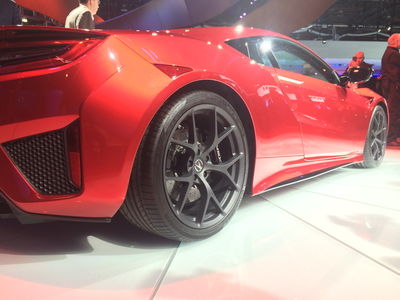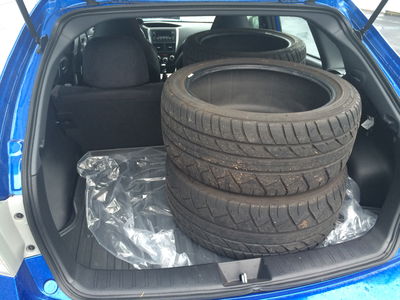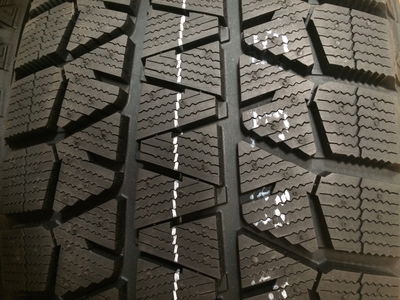Engineering Explained: Everything You Need To Know About Summer, Winter & All-Season Tyres

For road cars, tyres often come in three varieties: summer, all-season, and winter. There are an immense amount of factors involved in selecting a tyre that performs best: compound, tread design, width, stiffness, construction and type, loading, wear characteristics, inflation pressure, etc. Let this be an amateur’s guide to learning a thing or two about tyres.
Summer Tyres
The idea behind a summer tyre is for maximum performance in warm, dry conditions. That said, many will perform acceptably if the road is wet (otherwise they likely wouldn’t have any tread at all). It’s often stated that summer tyres use a very soft rubber, which is why they’re so grippy and used in performance vehicles. Yet, if you were to put a summer tyre and a winter tyre side by side at room temperature, the winter tyre would feel far more flexible. It’s important to understand that while summer tyres are indeed soft, every tyre has a specific temperature range at which it performs best. The reason you see cars turning sharply left and right on straights in motorsport (and often during caution) is to either warm the tyres up or keep them at operating temperatures. At lower temperatures, summer tyres are much more firm and won’t provide optimum traction.
So if winter tyres are softer than summer tyres at room temperature, why not use these compounds in racing? Simply put, the tyre would disintegrate. Winter tyres are not made to handle high amounts of friction persistently as summer tyres are. As the tyre warms up, it would wear incredibly quickly. This is why it’s considered a bad idea to run winter tyres all year round, as you’ll be replacing them far more often due to excessive wear in the summer.
Summer tyres will typically have less tread than all-season or winter tyres, they’ll have compounds which can handle more heat and wear less at higher temperatures where they will have the highest lateral (and longitudinal) grip, and they will offer increased responsiveness as they won’t have as much roll as softer compounds (at lower temperatures) with softer sidewalls.

All-Season Tyres
An all season tyre is purely a compromise. It’s not really the best at anything, but it can do everything adequately. The main advantage over a summer tyre is that with more tread depth, they are less susceptible to hydroplaning. When it comes to wet driving, the compound is highly important with regards to grip. That said, if the compound cannot touch the road (in the case of hydroplaning, where the tyre is incapable of pushing the water outside of the contact patch) then all bets are off, and it’s obviously better to have something that can actually maintain contact.
The tread compound will wear more than a summer tyre at high temperatures, and perform worse than a winter tyre in low temperatures. The reason they’re so common is because it’s a one size fits all. Put on all seasons, and you’re ready for any season. Tyre technology has come so far that it’s a perfectly acceptable solution; it just won’t offer maximum performance.

Winter Tyres
Praise the naming scheme of tyres because winter tyres do well in cold weather. The compound selected is much softer at cold temperatures, keeping it pliable, allowing it to bend and conform with the road (or snow, ice, etc) and maintain traction. Aside from the compound, there are several factors that make a winter tyre a top choice for cold climates:
- Tread depth: High tread depth allows for maintaining contact while driving through water or slush, and it also helps to pack in snow. Though it may not seem entirely intuitive, snow on snow traction is actually pretty good, so packed snow in a tyre helps while travelling on the white stuff.
- Sipes: These are small cuts in the tyre tread blocks. They all act as leading edges that grip irregularities in the road, holding the tyre in place. These days they are often zigzagged which allows for increased rigidity of the tread as well as better lateral grip.
- Studs: Though no longer completely necessary, the benefit of studs is fairly obvious. Studs dig into the snow and ice, providing significantly more traction. The downside is they’re loud and they destroy roads, and studless tyres have advanced enough that they’re not completely necessary anymore.
- Hydrophilic Pours: When you’re driving on ice, there can often be a thin layer of water on top of the ice, either from melt or the pressure of the tyre. This essentially makes traction impossible. Hydrophilic pours help draw away this water from the ice, and hold it within the tyre itself as it travels over the road. Centrifugal force slings the water out after the rubber is no longer in contact with the road.
Here’s a video explaining winter tires in further detail:
Understanding summer, all-season, and winter tyres barely scratches the surface of the engineering behind tyres. Vehicle dynamics is an equally important topic to discuss, and much of this relates to slip angles.
A slip angle, simply put, is the difference between the direction the tyre is travelling versus the direction the wheel is pointing. Rubber is elastic, so as you turn the steering wheel, friction between the road and the tyre resists the turn, so the contact patch does not travel the exact direction the wheel is pointed.
Here’s more on slip angles:
Whether a car understeers (corners wider than desired, front tyres slip) or oversteers (corners sharper than desired, the back slides out), it all relates back to slip angles, and is a result of the desired grip exceeding the grip of the tyre. When the front slip angle is larger than the rear slip angle, the car will understeer. If the rear slip angle is larger, the car will oversteer.
As described in the following video, there are many ways to alter the steering characteristics of a vehicle:
The reason for understeer and oversteer comes down to the tyre’s ability to maintain grip with the road as a result of the accelerative forces placed on the tyre. The traction circle is a tool used to help describe how tyres behave. If all of the friction of a tyre is used for braking (or cornering), it can hold a certain g-force without sliding. If you add cornering to braking, or accelerating to cornering, the maximum lateral grip and longitudinal grip will both decrease, but the sum of the lateral and longitudinal forces of the tyre will be greater than if you were to only be braking or cornering.
Confused? Let me simplify. Let’s say a car can brake at 1g, or corner at 1g. These are exclusive of one another. If we enter a corner and are braking, the maximum lateral grip will be about 0.7g, while simultaneously the maximum braking grip will be about 0.7g. Now obviously 0.7 is less than 1, but you’re doing this in two directions, so the cumulative grip is higher, and you will be able to travel faster around a track by combing braking or accelerating with cornering rather than doing them separately.
Still curious about how this works? I’ll break down the maths in this video:
Now lets relate it all back to understeering and oversteering. If you’re coming up to a corner on a track, first you start braking, and then you start turning the vehicle. The front tyres are trying to do a lot of work. Assuming most of your load transfer (another topic altogether) has travelled to the front tyres, the tyres are doing their best to slow the vehicle when you’ve now added a lateral force. These front tyres can only do so much, so if the lateral force you impose on the tyre is greater than the force it can hold (you’ve moved the dot outside of the traction circle) your front tyres will start to slip, and now you’re understeering.
If you’re exiting a corner, your tyres have a lateral force that they are holding. As you press down on the accelerator pedal (assuming rear wheel drive), you’re now telling the rear tyres to both hold the corner and accelerate out, and if your foot is more ambitious than your tyres, the rear end will start to slide out. You might be smiling though, assuming you’re still on the track.














Comments
No comments found.